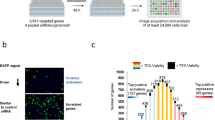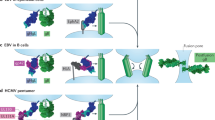Abstract
Earlier this laboratory constructed a herpes simplex virus 1 recombinant (R5111) that carries a IL13 ligand inserted into glycoprotein D and can enter cells via the IL13Rα2 receptor commonly expressed on the surface of malignant glioma cells. In this report, we describe the properties of two recombinant viruses carrying chiemric gD genes. In R5181 recombinant virus the chimeric gene consisted on the residues 20–155 of urokinase plaminogen activator (uPA) inserted between residues 24 and 25 of gD. In R5182 the insert consisted of a 23-residue sequence encoding the uPA binding domain for the urokinase plaminogen activator receptor (uPAR). These viruses were constructed for three reasons, to increase the number of viruses that specifically target receptors on the surface of malignant glioma cells, to determine whether viruses exhibiting novel ligands could enter cells via receptors anchored to the cell surface via glycosylphosphatidylinositol anchor as has been recently demonstrated for nectin1, and to determine whether receptors other than IL13Rα2 could be targeted by genetic engineering of the virus. We report that R5181 but not R5182 recombinant virus was able to enter cells expressing uPAR. The results indicate that HSV-1 recombinant viruses can be engineered to enter cells via a variety of unrelated nonviral receptors, including receptors that are anchored to the cells surface but without transmembrane domains.
This is a preview of subscription content, access via your institution
Access options
Subscribe to this journal
Receive 12 print issues and online access
$259.00 per year
only $21.58 per issue
Buy this article
- Purchase on Springer Link
- Instant access to full article PDF
Prices may be subject to local taxes which are calculated during checkout










Similar content being viewed by others
References
Markert JM, Medlock MD, Rabkin SD, Gillespie GY, Todo T, Hunter WD et al. Conditionally replicating herpes simplex virus mutant, G207 for the treatment of malignant glioma: results of a phase I trial. Gene Therapy 2000; 10: 867–874.
Rampling R, Cruickshank G, Papanastassiou V, Nicoll J, Hadley D, Brennan D et al. Toxicity evaluation of replication-competent herpes simplex virus (ICP 34.5 null mutant 1716) in patients with recurrent malignant glioma. Gene Therapy 2000; 7: 859–866.
Roizman B, Knipe DM . Herpes simplex viruses and their replication. In: Knipe DM, Howley P, Griffin DE, Lamb RA, Martin MA, Roizman B, Straus SE (eds). Fields Virology, 4th edn. Lippincott Williams & Wilkins: New York, 2001, pp 2399–2459.
Zhou G, Ye GJ, Debinski W, Roizman B . Engineered herpes simplex virus 1 is dependent on IL13Ralpha 2 receptor for cell entry and independent of glycoprotein D receptor interaction. Proc Natl Acad Sci USA 2002; 99: 15124–15129.
Laquerre S, Argnani R, Anderson DB, Zucchini S, Manservigi R, Glorioso JC . Heparan sulfate proteoglycan binding by herpes simplex virus type 1 glycoproteins B and C, which differ in their contributions to virus attachment, penetration, and cell-to-cell spread. J Virol 1998; 72: 6119–6130.
Zhou G, Roizman B . Characterization of a recombinant herpes simplex virus 1 designed to enter cells via the IL13Ralpha2 receptor of malignant glioma cells. J Virol 2005; 79: 5272–5277.
Gianni T, Campadelli-Fiume G, Menotti L . Entry of herpes simplex virus mediated by chimeric forms of nectin1 retargeted to endosomes or to lipid rafts occurs through acidic endosomes. J Virol 2004; 78: 12268–12276.
Gladson CL, Pijuan-Thompson V, Olman MA, Gillespie GY, Yocoub IZ . Up-regulation of urokinase and urokinase receptor genes in malignant astrocytoma. Am J Pathol 1995; 146: 1150–1160.
Yamamoto M, Sawaya R, Mohanam S, Rao VH, Bruner JM, Nicholson GL et al. Expression and localization of urokinase-type plasminogen activator receptor in human gliomas. Cancer Res 1994; 54: 5016–5020.
Ploug M, Ronne E, Behrendt N, Jensen AL, Blasi F, Dano K . Cellular receptor for urokinase plasminogen activator. Carboxyl-terminal processing and membrane anchoring by glycosyl-phosphatidylinositol. J Biol Chem 1991; 266: 1926–1933.
Moller JV, le Maire M . Detergent binding as a measure of hydrophobic surface area of integral membrane proteins. Biol Chem 1993; 268: 18659–18672.
Cantero D, Friess H, Deflorin J, Zimmermann A, Brundler MA, Riesle E et al. Enhanced expression of urokinase plasminogen activator and its receptor in pancreatic carcinoma. Br J Cancer 1997; 75: 388–395.
Zhou G, Roizman B . The domains of glycoprotein D required to block apoptosis depend on whether glycoprotein D is present in the virions carrying herpes simplex virus 1 genome lacking the gene encoding the glycoprotein. J Virol 2001; 75: 6166–6172.
Nelles L, Lijnen HR, Collen D, Holmes WEJ . Characterization of recombinant human single chain urokinase-type plasminogen activator mutants produced by site-specific mutagenesis of lysine 158. J Biol Chem 1987; 262: 5682–5689.
Wei Y, Waltz DA, Rao N, Drummond RJ, Rosenberg S, Chapman HA . Identification of the urokinase receptor as an adhesion receptor for vitronectin. J Biol Chem 1994; 269: 32380–32388.
Roller RJ, Roizman B . The herpes simplex virus 1 RNA binding protein US11 is a virion component and associates with ribosomal 60S subunits. J Virol 1992; 66: 3624–3632.
Reuning U, Magdolen V, Wilhelm O, Fischer K, Lutz V, Graeff H et al. Multifunctional potential of the plasminogen activation system in tumor invasion and metastasis (review). Int J Oncol 1998; 13: 893–906.
Fowler B, Mackman N, Parmer RJ, Miles LA . Binding of human single chain urokinase to Chinese Hamster Ovary cells and cloning of hamster u-PAR. Thromb Haemost 1998; 80: 148–154.
Roldan AL, Cubellis MV, Masucci MT, Behrendt N, Lund LR, Dano K et al. Cloning and expression of the receptor for human urokinase plasminogen activator, a central molecule in cell surface, plasmin dependent proteolysis. EMBO J 1990; 9: 467–474.
Englund PT . The structure and biosynthesis of glycosyl phosphatidylinositol protein anchors. Annu Rev Biochem 1993; 62: 121–138.
Barnathan ES, Kuo A, Rosenfeld L, Kariko K, Leski M, Robbiati F et al. Interaction of single-chain urokinase-type plasminogen activator with human endothelial cells. J Biol Chem 1990; 265: 2865–2872.
Acknowledgements
We thank Dr G Campadelli Frume for the J1.1, J-HveA and J-Nectin cell line, Dr DA Dichek for the pULscuPA plasmids and Dr HA Chapman for the plasmids containing a human uPAR cDNA, respectively. The studies conducted at the University of Chicago were aided by National Cancer Institute Grants CA CA87661, CA83939, CA71933, CA78766, and CA88860. HK was the recipient of a JHIF Scholarship Award.
Author information
Authors and Affiliations
Corresponding author
Rights and permissions
About this article
Cite this article
Kamiyama, H., Zhou, G. & Roizman, B. Herpes simplex virus 1 recombinant virions exhibiting the amino terminal fragment of urokinase-type plasminogen activator can enter cells via the cognate receptor. Gene Ther 13, 621–629 (2006). https://doi.org/10.1038/sj.gt.3302685
Received:
Revised:
Accepted:
Published:
Issue Date:
DOI: https://doi.org/10.1038/sj.gt.3302685
Keywords
This article is cited by
-
Oncolytic herpes simplex virus immunotherapy for brain tumors: current pitfalls and emerging strategies to overcome therapeutic resistance
Oncogene (2019)
-
Oncolytic virotherapy for urological cancers
Nature Reviews Urology (2016)
-
Pediatric cancer gone viral. Part I: strategies for utilizing oncolytic herpes simplex virus-1 in children
Molecular Therapy - Oncolytics (2015)
-
Mutations in herpes simplex virus gD protein affect receptor binding by different molecular mechanisms
Journal of Molecular Modeling (2014)
-
Replication-competent Herpes Simplex Virus Retargeted to HER2 as Therapy for High-grade Glioma
Molecular Therapy (2012)



